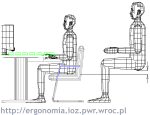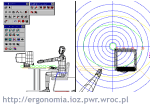 | | |  |  | 3D Digital Mankins in AutoCAD |
| |
|
|
|
| | 3D Mankins in AutoCAD | Get demo version |
Features

|
The Apolinex software was created within a framework of the AutoCad environment, which is one of the most widespread CAD type systems working under MS Windows systems.
|
The program allows for building virtual representations of the most common human body dimensions specified by percentiles of the body height.
Threedimensional digital human being model is available within the AutoCad graphical user inteface and can be applied in any stage of the design process conducted in this system. The appropriate manikin is defined by the user in the dialogue window, in which one specifies:

|
- Nationality
- Gender
- Height centile (from 2.5 to 97.5)
- Manikin fraphical type (stick, standard)
- Working posture (sitting or standing)
- Body build type (5-thin, 50-medium and 95-heavy, centiles of each segment circumference).
|
After all human body elements have been defined, the user points to the location on the design scene, where the mannequin should be placed. The system will then construct appropriate mannequin model based on scaling of basic graphical segments contained in the database.
Apolinex uses population data described by Pheasant (1991) as a basis for specification of design parameters activation of the APOLINEX system, after its installation in the appropriate files of AutoCAD, includes recalling of the hierarchically built set of menu options on the computer screen (that is, ruler on the right hand side of the AutoCAD screen).
Selection of specific options involves pointing with the help of a mouse to an appropriate segment (or section with the specific name in the menu), and activation of the confirm key. The basic functions that control the motion of the mannequin allow for movement of any segment or the whole mannequin.
The body segments can be moved using rotation around the appropriate axis, with help of the local coordinates which can be seen on the computer screen, and which are accessible from the list of screen menu elements. The basic way of performing the body motion is based on one or two clicks of the mouse. First, using the menu, one determines the axis of rotation (up- down, left-right, around). Next, with the help of a cursor, one can mark specific elements and, consequently, move them around as needed.
Application

|
The basic Apolinex features enable the user to perform fast analyses of the spatial relationships in the virtual design scene. If, for instance, one designs sitting workplace, the use of two threshold manikins, that is 5th and 95th centile, will provide the sitting pan range of regulation necessary for the selected population.
|
If the working activities include the operation of devices requiring manipulation, one may specify minimal distances to those objects by choosing a 5 centile individual and positioning his body segments in such a way that they simulate the operation process of those tools.

|
In any time the designer can produce a basic field of view of the manikin. It is also possible to generate the grid which shows the visual field items at places specified by solid angles. The eye sight line is set horizontally in relation to the floor, however it can be modified according to the designer's need, just like any other body segment.
|
The Apolinex can also be applied for work load analysis. It is being done by calculating joint moments for specific body segments to assess the biomechanical workload. The system generates geometrical data for a given mannequin and then calculates joint moments taking into consideration specific loads put in the manikin's hands.

|
The diagrams of the joint moments are generated for two selected from the scene manikins simultaneously. This allows for making direct comparisons of various postures and design solutions.
|
|
| |
